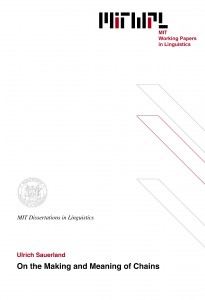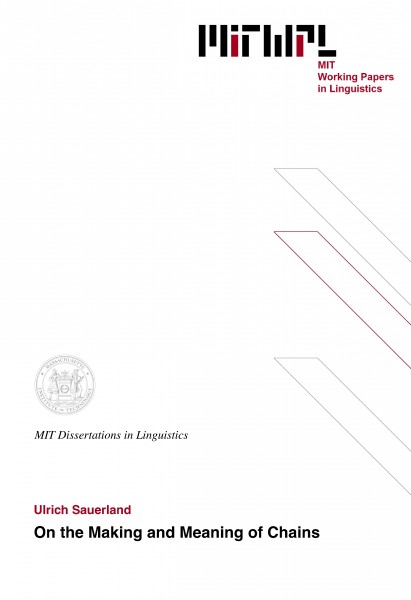The Meaning of Chains
U. Sauerland, 1998
This thesis investigates the mechanisms applying in the interpretation of syntactic chains. The theoretical background includes a translation of syntactic forms into semantic forms and a model theoretic explication of the meaning of semantic forms. Simplicity considerations apply to all three stages of the interpretation process: syntactic derivation, translation into semantic forms, interpretation of semantic forms.
Three main results are achieved. The first is that trace positions can have semantic content beyond what is needed for the semantic dependency of trace and binder. This extra contenet is some or all of the lexical material of the head of the chain, as expected on the copy theory of movement. Two independent arguments support this conclusion. One, discussed in chapter 2, is based on the distribution of Condition C effects, where novel interactions between variable binding, antecedent contained deletion and Condition C are observed. The second, developed in chapter 3, is based on conditions on the identity of traces observed in antecedent contained deletion constructions. Both arguments lead to the same generalizations about what lexical material of the head is interpreted in the trace position.
The second main result is that lambda calculus is superior to both standard predicate logic and combinatorial logic as the mathematical model for the semantic mechanism mediating the dependency of trace (or bound pronoun) and binder. Chapter 4 argues this on the basis of the distribution of focus and destressing in constructions with bound pronouns.
The third main result is that quantification must be allowed to range over pointwise different choice functions. Chapter 5 shows that quantification over individuals is sufficient, and that pointwise different choice functions are required. The result entails that the syntactic difference of A-chains and A-bar chains predicts a semantic difference in the type of the variable involved, which is argued to explain weak crossover phenomena.
Chapter 6 argues that the interpretation procedures developed in the preceding chapters account for all cases. It is shown that only traces of the type of individuals arise, and that scope reconstruction is a phonological phenomenon. The latter result also supports the T-model of syntax.
Table of Contents
1 Introduction 13
1.1 Background assumptions 14
1.2 Overview 17
2 Binding into Traces 29
2.1 Scope, Condition C and Antecedent Contained Deletion 34
2.2 Variable binding and Condition C 43
2.3 The A/A-bar distinction 54
2.4 Relative clause internal traces 60
2.4.1 Two LF-structures for relative clauses 65
2.4.2 The internal head of matching relatives 75
2.5 Summary 88
3 Identity of Traces 93
3.1 A copy identity account of Kennedy’s puzzle 99
3.2 Semantic content of the trace 113
3.3 Wh-traces and focus in chains 137
3.3.1 Pseudogapping and traces 141
3.3.2 Focus and wh-traces 144
3.3.3 Domain expansion and focus index sloppiness 161
3.4 Summary 180
4 Linking Trace and Antecedent 185
4.1 Variable or combinators 192
4.1.1 Forcing different indices 203
4.1.2 Forcing index identity 206
4.2 Predicates or formulas 227
4.3 Summary 234
5 Interpreting Moved Quantifiers 237
5.1 A choice function approach to all quantifiers 240
5.2 Predictions of the approach 263
5.3 Summary 266
6 Conclusion/Outlook 269
6.1 The type of traces 270
6.2 Scope (or total) reconstruction 276
6.2.1 A PF-movement account of scope reconstruction 280
6.2.2 The scope freezing generalization 284

